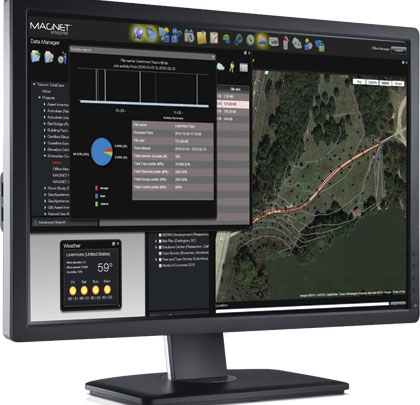Part 1 of this article presented the backstory of technological evolution and the emergence of the cloud, leading to the big question: How can the cloud help with profitable projects in the survey and construction industries?
THINGS TO KNOW ABOUT SWITCHING
The term “cloud computing” is a broad umbrella under which many subdivisions fall. Construction contractors, land surveyors, GIS professionals, and 3D model builders will encounter specific cloud-based applications or services being offered via subscription.
One such service is Topcon’s MAGNET® Enterprise, which offers the ability to pause and represent companies of all sizes within their own private cloud-based company account. At the core of the MAGNET system of software solutions, MAGNET Enterprise allows managers to start with a simple street address and quickly create geo-referenced projects with the click of a mouse or tap of the finger. Managers can then assign employees (think permissions) to specific projects and tasks, and instantly have a dashboard to check any project’s status. It is designed to function as a connection hub for collaboration and to keep projects moving forward. Additionally, managers can have access to the details of past projects—timelines, who worked on the projects, and costs—which are archived for future reference.
With the cloud, there is the easy access and secure exchange of information between the common organization triangle of manager, office, and field staff for design changes and project updates. Before company accounts in the cloud were available, if there was a need to communicate information to the field (e.g., a design change), there were three options: send an email, deliver a thumb drive, or make a phone call. Whatever method was used took time, which had an eventual impact on productivity and a project’s overall profitability.
THE NEXT BIG THING
Cloud surfing? It’s super easy to do and extremely valuable. The term cloud surfing describes the option of connecting independent cloud services to each other. For example, Autodesk offers the no-cost cloud service of AutoCAD 360. Through it, users can view, create, edit, and share drawing files at no cost using smartphones, tablets, or desktop devices.
MAGNET Enterprise supports cloud surfing by offering the ability to add AutoCAD 360 service credentials. Working within MAGNET Enterprise, users can then easily “point to” Autodesk’s cloud for additional file storage and instant sharing.
MAGNET Enterprise cloud surfing connections are realized in the common scenario of designers in the office needing to deliver a change with special instructions to workers at an active jobsite. It makes no difference if the jobsite is across the street or on the other side of the globe.
Using any web browser, updated drawing files can be uploaded to services like AutoCAD 360 for quick viewing and potential redline edits. Project managers can then log into their private MAGNET Enterprise company account, click on the AutoCAD 360 option, and see all files within their AutoCAD 360 account. Meanwhile, field crew members at a jobsite can log into their private cloud-based company account and download the new drawing.
The value of this cloud surfing connection becomes apparent when employees no longer need to waste time in traffic or wait to get back to the office to discuss what has been done on a project. Direct data sharing to any project site is now instant and easy.
Project data can flow in both directions, meaning both office staff and field crews have access to upload and download project related files by having all project members use the same cloud-based project inbox, which also serves as an instant backup. Because data is being shared instantly, results can be seen immediately.
In the old days (only a few years ago), raw files were moved between the office and field via whatever means were available at the time. Now there is a virtual pipeline of information exchange to and from project sites.
Managers can leverage cloud-based company accounts as a project coordination tool. Within MAGNET Enterprise, managers have an at-a-glance dashboard to instantly see all of the company’s projects intuitively plotted on top of a streaming satellite image background. Confidence is bolstered after quick verification of the fieldwork that has been done so far, as well as all the other jobs in process.
SECURITY CONCERNS
For those who are new to the cloud and the services that are offered, there are generally two reactions: raised eyebrows acknowledging the impressiveness of cloud technology, followed quickly with concerns about the security.
It is important to understand that access to a private cloud-based company account is only accomplished through a secure login. An employee’s email and custom password functions as a fingerprint for gaining access, and access only to the specific project to which the employee has been assigned. Also, remember that the parallel benefit of cloud systems is that all data is redundantly located in many places.
THE NEAR FUTURE
While the future is not set in stone, experts tend to agree on the following predictions for cloud-based computing:
- In a short 3 years from now, no one will be talking about the cloud. It will have become the new normal.
- There will in fact be many clouds and companies/users will be able to customize the personal cloud environment to precisely fit unique needs. There will not be cumbersome giant generic software applications intending to meet disparate needs of users all over the world.
- In the future, the question that will be asked to qualify any software or services under consideration, “Is it cloud enabled and does it have the flexibility to meet our specific needs?”
The future is closer than one might think. Now is the time. It’s time to put one’s “head in the clouds.” ■
About The Author Oscar R. Cantu’ is a product marketing manager for software within Topcon Positioning Systems.
Modern Contractor Solutions, October 2014
Did you enjoy this article?
Subscribe to the FREE Digital Edition of Modern Contractor Solutions Magazine!



